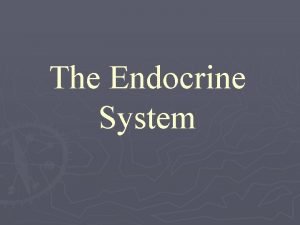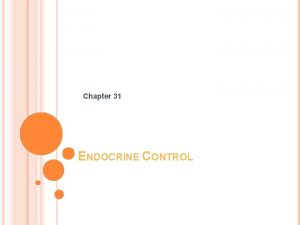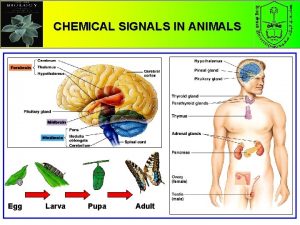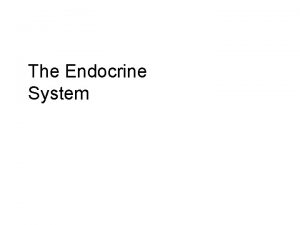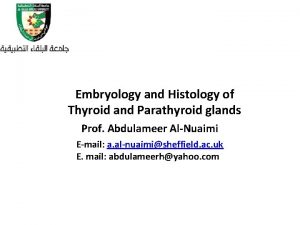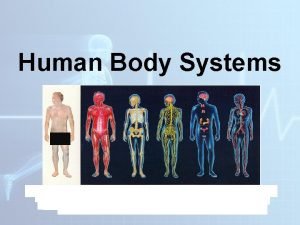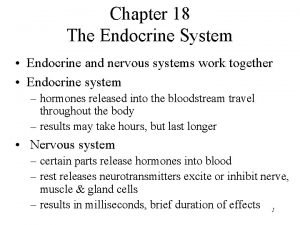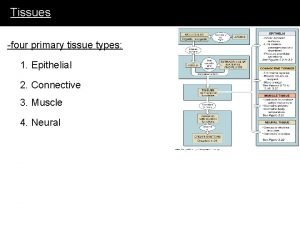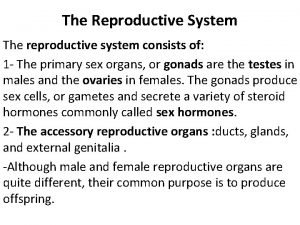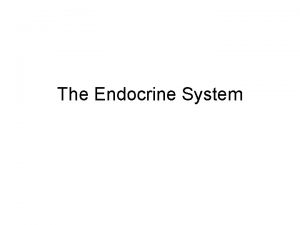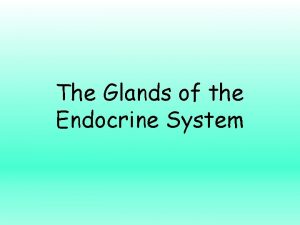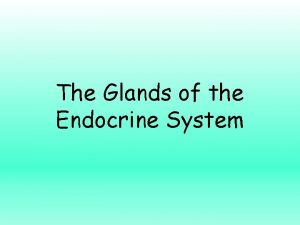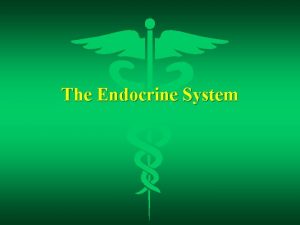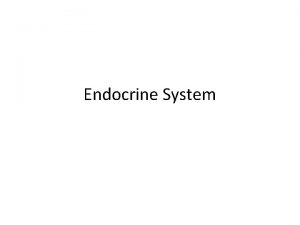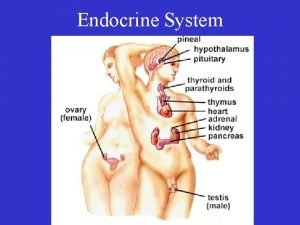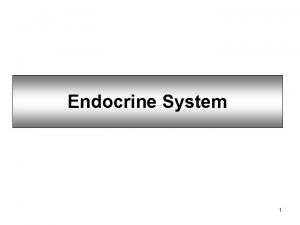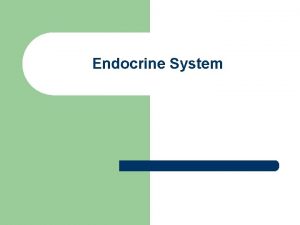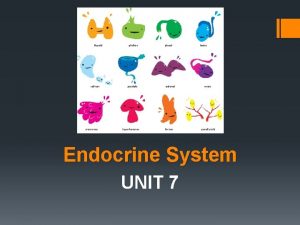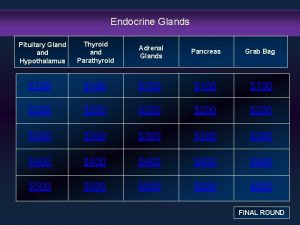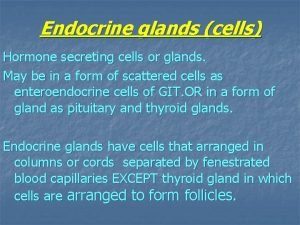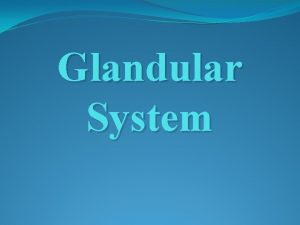Chapter 20 The Endocrine Glands Endocrine Functions and


































- Slides: 34

Chapter 20 The Endocrine Glands

Endocrine Functions and Dysfunctions • Endocrine glands release hormones directly into the blood to regulate various metabolic functions • The major endocrine glands – Pituitary – Thyroid – Parathyroid – Adrenal cortex and medulla – Pancreatic islets – Ovaries and testes

Endocrine Functions and Dysfunctions • Feedback mechanisms – The amount of hormone synthesized and released by a gland may be regulated: • Directly: • Indirectly: – Negative feedback systems are most commonly used • An increase in hormone or hormone-regulated substance leads to:

Pituitary Gland • Suspended by stalk from hypothalamus at base of brain – Composed of: • Anterior lobe: – Growth hormone: – Prolactin: – Thyroid-stimulating hormone (TSH): – Adrenocorticotrophic hormone (ACTH): – Follicle-stimulating hormone (FSH): – Luteinizing hormone (LH): • Posterior lobe: – Antidiuretic hormone (ADH): – Oxytocin:


Pituitary Gland

Normal mechanisms controlling elaboration of tropic hormones by the pituitary gland

Pituitary Hypofunction • Panhypopituitarism is a condition in which the: – Leads to impaired function of: • Pituitary dwarfism is a condition that occurs when a child has a deficiency of: – Causes:

Pituitary Hypofunction • Diabetes insipidus is a disease caused by failure of the: – Can be caused by: – Unable to absorb: – Causes excretion of: – Person will compensate by:

Pituitary Tumors • Many pituitary endocrine disturbances caused by anterior lobe pituitary tumors – Functional tumors: • Clinical manifestations depend on: – Nonfunctional tumors: • May encroach on important surrounding structures – Treatment determined by type, size, and hormone produced by tumor • Drugs to suppress tumor growth • Surgical resection: usual surgical approach is through the nasal cavity

Pituitary Tumors • Growth hormone overproduction caused by a tumor – Causes excessive growth in length of bones at growth plate (epiphyses) in children which is called: • The effected person will become too tall – Causes thickening of bones and enlargement of viscera in adults which is called: • Does not alter height since epiphyses are closed • Prolactin overproduction caused by a tumor – Causes: • galactorrhea: • Amenorrhea:

Acromegaly Gigantism Fig. 20 -3

Thyroid Gland • Found in the neck overlying the upper section of trachea • Consists of two lateral lobes connected by a narrow isthmus • Composed of thyroid follicles that produce and store thyroid hormone – Hormone production regulated by: • Actions – Controls rate of: – Required for normal:

Thyroid Gland

Normal thyroid gland, illustrating two lateral lobes connected by narrow isthmus Fig. 20 -4

Thyroid Gland • Hyperthyroidism: • Hypothyroidism: Hyperthyroidism Hypothyroidism Rapid pulse Slow pulse Increased metabolism Decreased metabolism Hyperactive reflexes Sluggish reflexes Emotional Placid GI effect: diarrhea GI effect: constipation Warm, moist skin Cold, dry skin

Nontoxic Goiter • Thyroid gland enlarges to increase hormone secretion – Caused by inadequate secretion of: • 3 major factors predispose – Iodine deficiency » Iron is needed to: – Enzyme deficiency or impaired enzyme function » Enzyme is needed to: – Increased hormone requirements • Treatment: administer thyroid hormone; may need surgical removal

The pathogenesis of nontoxic goiter Fig. 20 -5

Toxic Goiter/Hyperthyroidism • Excess secretion of: – Usually caused by an autoimmune disease in which autoantibodies target cells of the: • Autoantibodies bind to TSH receptors and cause: • Normal control mechanisms are lost • This condition is also called: • Treatment – Antithyroid drugs, thyroidectomy, large doses of radioactive iodine

Toxic Goiter goiter Fig. 20 -7 Large nodular Fig. 20 -6

Hypothyroidism • In adult – Individuals have low levels of: – Causes slowing of: – Treatment: & high levels • In an infant – May be caused by: • Failure of the thyroid gland to: • Deficiency of enzymes needed for: – If left untreated will cause perm stunting of growth and mental retardation which is called: • All newborn infants are screened • Early diagnosis and treatment required for normal development

Chronic Thyroiditis • Preferably referred to as: • Immune system develops autoantibodies that destroy: • Results in hypothyroidism • Cant stop disease progression of disease but can give thyroid hormone

Parathyroid Glands • Blood calcium levels are in equilibrium with calcium in bones – Adequate blood calcium levels are needed for normal cardiac & skeletal muscle contraction, nerve impulse transmission, & blood clotting • Parathyroid hormone regulates calcium levels by: – Regulating the release of calcium from: – Absorption of calcium in the: – Excretion of calcium by the:

Hyperparathyroidism • Increased levels of parathyroid hormone • Usually from a hormone-secreting parathyroid tumor • Increased output of hormone causes: – Hypercalcemia: – Excessive calcium is withdrawn from: • Bones become: – Excessive calcium excreted in urine – Treatment:

Hypoparathyroidism • Decreased levels of parathyroid hormone • Usually from accidental removal of parathyroid glands during thyroid surgery • Decreased output of hormone causes: – Hypocalcemia: – Leads to neuromuscular: • Treatment: raise calcium levels – High-calcium diet – Supplementary vitamin D

Adrenal Gland • Adrenals: paired glands above kidneys • Consists of an inner medulla and outer cortex – Each region secretes different hormones

Adrenal Cortex • Secretes 3 major classes of hormones – Glucocorticoids • Raise blood glucose by – Promoting glucose utilization in tissues – Promoting fat and protein breakdown • Suppress inflammation • Major hormone is: – Mineralocorticoids • Regulate electrolyte & water balance by promoting absorption of sodium & water, & excretion of potassium in the kidneys • Major hormone is: – Sex hormones • Produce small amounts of estrogen & testosterone in males and females

Addison Disease • Addison Disease occurs with: – Results from: • Most cases are caused by an: – Glucocorticoid (cortisol) deficiency results in: – Mineralocorticoid deficiency results in an inability to regulate: • Sodium concentration of the blood falls as well as: – Treat by administering deficient hormones

Cushing Disease and Syndrome • Cushing Disease and Syndrome – Glucocorticoid excess causes: • Blood glucose: • Protein synthesis is impaired & proteins are: – Leads to: • Fat accumulates on trunk & extremities appear: • Skin becomes thin and easily: • Face appears full & round which is referred to as: – Mineralocorticoid excess leads to increase in:

Cushing’s disease before treatment. Fig. 20 -12

Adrenal Medulla • Produces catecholamines that stimulate the sympathetic nervous system – Norepinephrine (noradrenaline) – Epinephrine (adrenaline) • Pheochromocytoma is a tumor that secretes large amounts of: – Produces high blood pressure (hypertension) & increased heart rate – May cause cerebral hemorrhage from: – Symptoms may come and go or may be continuous – Treatment:

Pancreatic Islets • Diabetes Mellitus was discussed in Chapter 16

Gonads • Two functions – Production of germ cells – Production of sex hormones: controlled by gonadotropic hormones of pituitary gland FSH and LH • Tumors may secrete hormones • Treatment: surgical excision

? ? Questions? ?
 Merocrine glands vs apocrine glands
Merocrine glands vs apocrine glands Major endocrine glands male and female
Major endocrine glands male and female Chapter 16 matching questions 6-10
Chapter 16 matching questions 6-10 Difference between endocrine and exocrine glands
Difference between endocrine and exocrine glands Whats the difference between endocrine and exocrine glands
Whats the difference between endocrine and exocrine glands Exocrine glands are ductless
Exocrine glands are ductless Thyroid gland cells
Thyroid gland cells Chapter 11 endocrine system
Chapter 11 endocrine system Endocrine glands
Endocrine glands What are chemical signals
What are chemical signals Endocrine glands
Endocrine glands Hyophysis
Hyophysis Glands of the endocrine system
Glands of the endocrine system Rat urinary system
Rat urinary system Chapter 46 digestive and endocrine disorders
Chapter 46 digestive and endocrine disorders A hormone
A hormone Chapter 39 endocrine and reproductive systems
Chapter 39 endocrine and reproductive systems Chapter 29 endocrine and metabolic disorders
Chapter 29 endocrine and metabolic disorders Chapter 19 endocrine and hematologic emergencies
Chapter 19 endocrine and hematologic emergencies Nontropic hormones
Nontropic hormones Biggest possum
Biggest possum Thyroid
Thyroid Parathyroid
Parathyroid Pineal and pituitary glands
Pineal and pituitary glands Pineal and pancreas glands
Pineal and pancreas glands 7:13 endocrine system
7:13 endocrine system Chapter 23 the endocrine system
Chapter 23 the endocrine system Your year of miracles
Your year of miracles Chapter 16 lesson 2 the male reproductive system
Chapter 16 lesson 2 the male reproductive system Chapter 18: the endocrine system answer key
Chapter 18: the endocrine system answer key Simple cuboidal epithelium
Simple cuboidal epithelium Glands in integumentary system
Glands in integumentary system Female reproductive system definition
Female reproductive system definition Double sheets of peritoneal membrane
Double sheets of peritoneal membrane Where are the gastric glands located
Where are the gastric glands located

